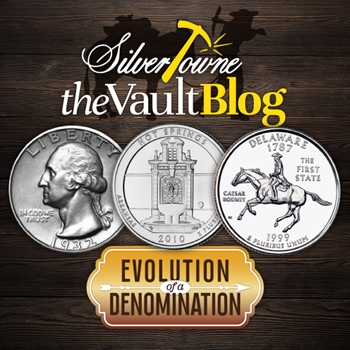
In 1931, the United States was in a dire state of economic depression. Unemployment, the impact of the Great Depression (which began in 1929 and lasted through the 1930s), and the Dust Bowl all contributed to the dampening of public morale. However during this, the birth of the nation’s first President of the United States, George Washington, was coming up on its 200th Anniversary. Officials decided to celebrate the occasion, leading to the design of the Washington quarter.
Washington Quarter (1932-Date)
The Treasury Department held a design competition that called for a design that celebrated the bust of George Washington that was originally designed by French sculptor Jean Antoine Houdon. Around 100 designs were submitted with just one sticking out among the rest. Submitted by Laura Gardin Fraser, the design was superior to all the others and the Commission of Fine Arts and the Washington Bicentennial Commission decided unanimously on her design. However, Congress was involved in the decision and their approval was necessary for the changing of the quarter dollar.
Upon that necessity, the pleasing of Treasury Secretary Andrew Mellon was also necessary. This would prove to be the biggest hurdle and his unwavering views on art and design mixed with his stubborn nature would overshadow the Commission’s decision to go with Fraser’s design. Instead, John Flanagan’s design would end up being the winner despite the call for another contest.
Beginning in 1932, the series would continue its run in 90% silver until 1965 when the composition would change to 75% copper and 25% nickel. In 1975, a modification of the design would occur due to the bicentennial anniversary of the United States. Jack Ahr’s drummer boy design would appear on the reverse with the dual date of 1776-1976 appearing on the obverse. In 1977, the design would return to its original form until it was once again altered in 1999 as the Statehood Quarter Program was introduced.
Washington Quarter, Statehood Quarters (1999-2008)
On October 20, 1996, the United States Commemorative Quarter Act was passed calling for each state to be celebrated with a reverse design for the Washington quarter. With five designs released each year, the 50-state quarters were recognized with a circulating quarter in addition to Proof and Mint Sets from the United States Mint. This caused Americans to search through their pocket change for the first time in many, many years. The program came to an end in 2008, however, Congress would approve the extension of the original bill so that the striking of six more commemorative quarters could be released celebrating the territories. They honored the District of Columbia, Guam, Puerto Rico, American Samoa, the U.S. Virgin Islands, and the Northern Mariana Islands.
Washington Quarter, America the Beautiful Quarters (2010-2021)
After the 50 Statehood Quarters Program ended, the authorization of the America’s National Parks Program took place. Struck from 2010 to 2021, 56 different quarters were issued representing a national park or national site within each of the 50 states in addition to the District of Columbia, Puerto Rico, Guam, American Samoa, the U.S. Virgin Islands, and the Northern Mariana Islands. Circulating quarter dollars were struck in addition to annual sets featuring them in Proof and Mint States conditions. In 2019 and 2020, a limited number of quarters were released into circulation featuring the ‘W’ mint mark. In addition, the 2020 quarters released also included a ‘V75’ privy mark to mark the 75th Anniversary of the end of the Second World War. The last of the series was released in 2021.
Source: NGC Coin; The Official 2023 Red Book







